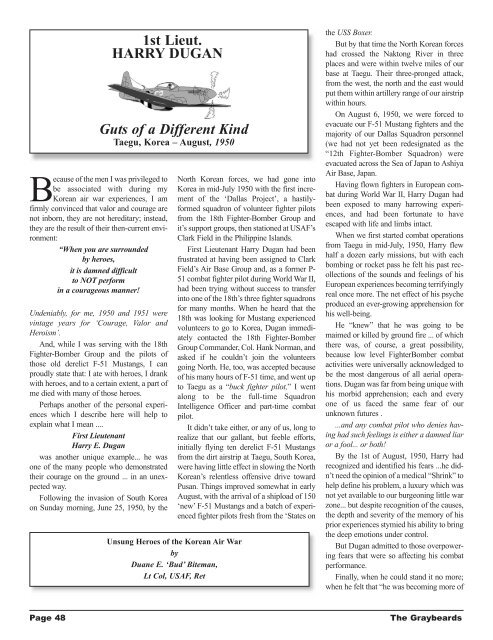The Graybeards - Korean War Veterans Association
The Graybeards - Korean War Veterans Association
The Graybeards - Korean War Veterans Association
Create successful ePaper yourself
Turn your PDF publications into a flip-book with our unique Google optimized e-Paper software.
1st Lieut.<br />
HARRY DUGAN<br />
Because of the men I was privileged to<br />
be associated with during my<br />
<strong>Korean</strong> air war experiences, I am<br />
firmly convinced that valor and courage are<br />
not inborn, they are not hereditary; instead,<br />
they are the result of their then-current environment:<br />
“When you are surrounded<br />
by heroes,<br />
it is damned difficult<br />
to NOT perform<br />
in a courageous manner!<br />
Undeniably, for me, 1950 and 1951 were<br />
vintage years for ‘Courage, Valor and<br />
Heroism’.<br />
And, while I was serving with the 18th<br />
Fighter-Bomber Group and the pilots of<br />
those old derelict F-51 Mustangs, I can<br />
proudly state that: I ate with heroes, I drank<br />
with heroes, and to a certain extent, a part of<br />
me died with many of those heroes.<br />
Perhaps another of the personal experiences<br />
which I describe here will help to<br />
explain what I mean ....<br />
First Lieutenant<br />
Harry E. Dugan<br />
was another unique example... he was<br />
one of the many people who demonstrated<br />
their courage on the ground ... in an unexpected<br />
way.<br />
Following the invasion of South Korea<br />
on Sunday morning, June 25, 1950, by the<br />
Guts of a Different Kind<br />
Taegu, Korea – August, 1950<br />
Unsung Heroes of the <strong>Korean</strong> Air <strong>War</strong><br />
by<br />
Duane E. ‘Bud’ Biteman,<br />
Lt Col, USAF, Ret<br />
North <strong>Korean</strong> forces, we had gone into<br />
Korea in mid-July 1950 with the first increment<br />
of the ‘Dallas Project’, a hastilyformed<br />
squadron of volunteer fighter pilots<br />
from the 18th Fighter-Bomber Group and<br />
it’s support groups, then stationed at USAF’s<br />
Clark Field in the Philippine Islands.<br />
First Lieutenant Harry Dugan had been<br />
frustrated at having been assigned to Clark<br />
Field’s Air Base Group and, as a former P-<br />
51 combat fighter pilot during World <strong>War</strong> II,<br />
had been trying without success to transfer<br />
into one of the 18th’s three fighter squadrons<br />
for many months. When he heard that the<br />
18th was looking for Mustang experienced<br />
volunteers to go to Korea, Dugan immediately<br />
contacted the 18th Fighter-Bomber<br />
Group Commander, Col. Hank Norman, and<br />
asked if he couldn’t join the volunteers<br />
going North. He, too, was accepted because<br />
of his many hours of F-51 time, and went up<br />
to Taegu as a “buck fighter pilot,” I went<br />
along to be the full-time Squadron<br />
Intelligence Officer and part-time combat<br />
pilot.<br />
It didn’t take either, or any of us, long to<br />
realize that our gallant, but feeble efforts,<br />
initially flying ten derelict F-51 Mustangs<br />
from the dirt airstrip at Taegu, South Korea,<br />
were having little effect in slowing the North<br />
<strong>Korean</strong>’s relentless offensive drive toward<br />
Pusan. Things improved somewhat in early<br />
August, with the arrival of a shipload of 150<br />
‘new’ F-51 Mustangs and a batch of experienced<br />
fighter pilots fresh from the ‘States on<br />
the USS Boxer.<br />
But by that time the North <strong>Korean</strong> forces<br />
had crossed the Naktong River in three<br />
places and were within twelve miles of our<br />
base at Taegu. <strong>The</strong>ir three-pronged attack,<br />
from the west, the north and the east would<br />
put them within artillery range of our airstrip<br />
within hours.<br />
On August 6, 1950, we were forced to<br />
evacuate our F-51 Mustang fighters and the<br />
majority of our Dallas Squadron personnel<br />
(we had not yet been redesignated as the<br />
“12th Fighter-Bomber Squadron) were<br />
evacuated across the Sea of Japan to Ashiya<br />
Air Base, Japan.<br />
Having flown fighters in European combat<br />
during World <strong>War</strong> II, Harry Dugan had<br />
been exposed to many harrowing experiences,<br />
and had been fortunate to have<br />
escaped with life and limbs intact.<br />
When we first started combat operations<br />
from Taegu in mid-July, 1950, Harry flew<br />
half a dozen early missions, but with each<br />
bombing or rocket pass he felt his past recollections<br />
of the sounds and feelings of his<br />
European experiences becoming terrifyingly<br />
real once more. <strong>The</strong> net effect of his psyche<br />
produced an ever-growing apprehension for<br />
his well-being.<br />
He “knew” that he was going to be<br />
maimed or killed by ground fire ... of which<br />
there was, of course, a great possibility,<br />
because low level FighterBomber combat<br />
activities were universally acknowledged to<br />
be the most dangerous of all aerial operations.<br />
Dugan was far from being unique with<br />
his morbid apprehension; each and every<br />
one of us faced the same fear of our<br />
unknown futures .<br />
...and any combat pilot who denies having<br />
had such feelings is either a damned liar<br />
or a fool... or both!<br />
By the 1st of August, 1950, Harry had<br />
recognized and identified his fears ...he didn’t<br />
need the opinion of a medical “Shrink” to<br />
help define his problem, a luxury which was<br />
not yet available to our burgeoning little war<br />
zone... but despite recognition of the causes,<br />
the depth and severity of the memory of his<br />
prior experiences stymied his ability to bring<br />
the deep emotions under control.<br />
But Dugan admitted to those overpowering<br />
fears that were so affecting his combat<br />
performance.<br />
Finally, when he could stand it no more;<br />
when he felt that “he was becoming more of<br />
Page 48 <strong>The</strong> <strong>Graybeards</strong>

















